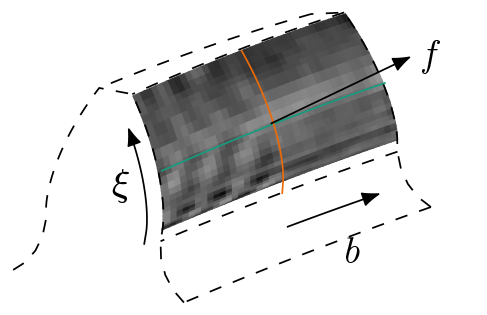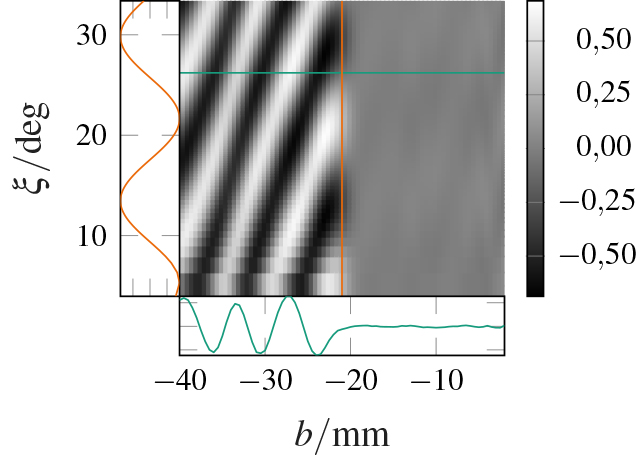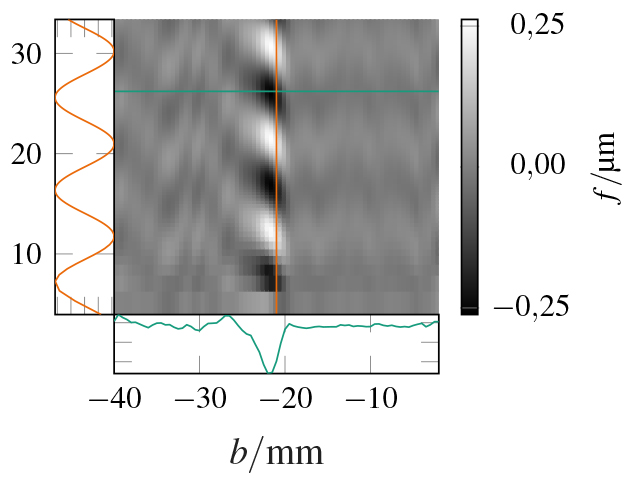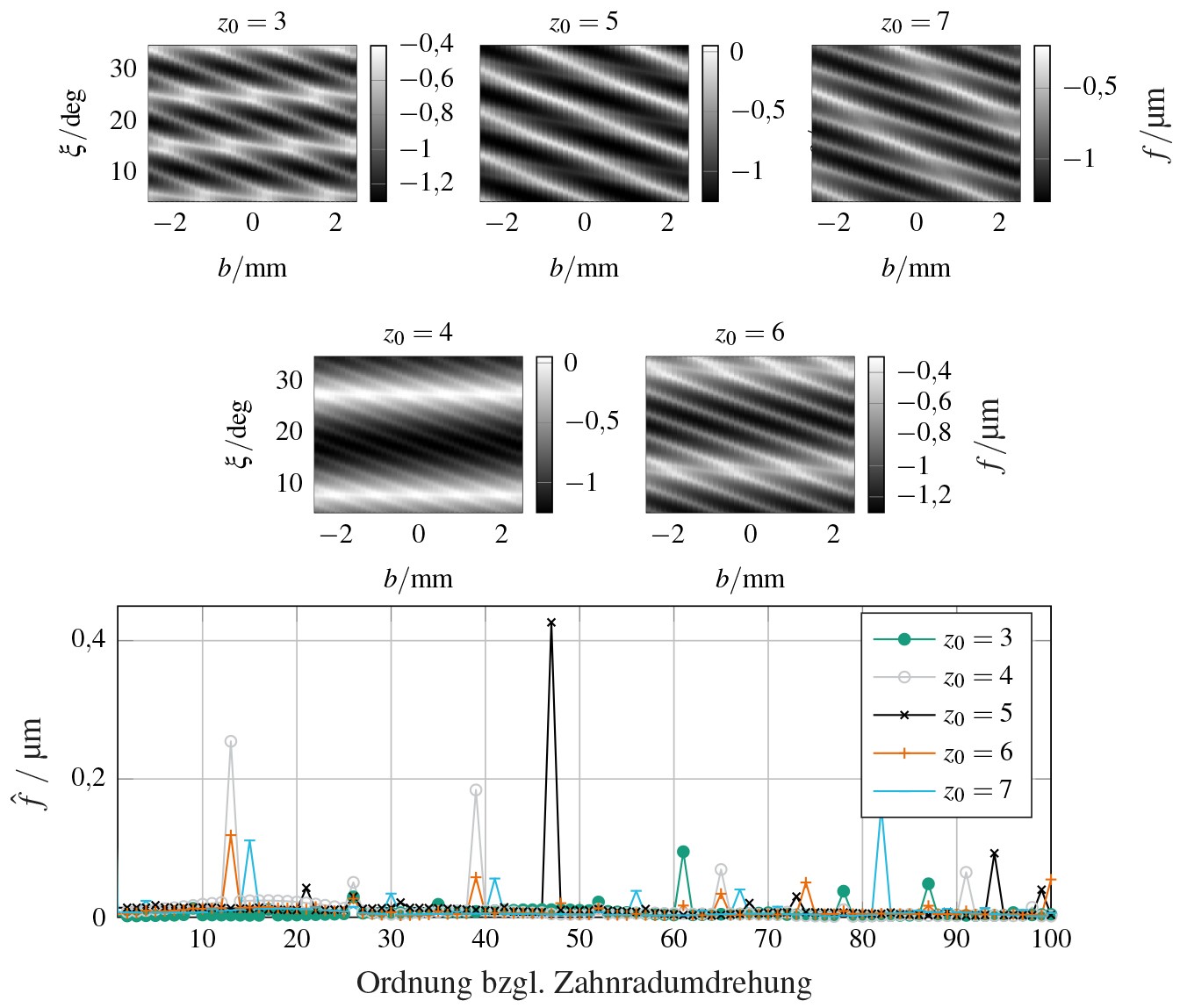In his dissertation, Simon Kimme develops a simulation model that describes the hard-fine machining of gears through continuous generating grinding. This creates an innovative basis for the assessment, elimination and prevention of noise-critical manufacturing influences, deviations and production processes.

Vibrational excitation in the tooth contact has been studied in depth as a process caused by various mechanisms. The displacement excitation due to a deviation from an involute profile is influenced to a significant extent both by the manufacturing process and specific modifications. The process-specific generation kinematics gives rise to significant differences between manufacturing processes. In continuous processes, such as generating grinding or honing, the process-related structures of the flank topography differ from tooth to tooth due to the feed movement in the axial direction. Caused above all by deviations in the manufacturing process, structures can arise on the tooth flank that leads to the excitation of orders during operation, regardless of the number of teeth.
This is challenging for the analysis of vibrational excitation in two respects. Firstly, it does not usually suffice to measure only one tooth and one profile or flank line in order to detect such structures. Secondly, a flank topography which varies from tooth to tooth must be taken into account to model the excitation in tooth contact. In contrast to identical first-order shape deviations in the teeth, which can be remedied by simple interventions in the process kinematics, more complex structures are difficult to attribute to a specific cause. This hinders accurate troubleshooting in the process chain.

Generating grinding is a widely used manufacturing process in hard-fine machining for medium to large quantities and is therefore the subject of the paper. Various models exist in the literature which model the machining of gears by means of generating grinding. However, the motivation behind these is usually to obtain a better understanding of the process as a prerequisite for technological optimisations. Accordingly, no adequate link has yet been drawn between a flank topography caused by errors in the process and the resulting excitation – thus providing the necessary basis for enabling machine manufacturers to detect and rectify critical process deviations.
For various reasons, the components caused by manufacturing processes are of particular importance within the diverse conglomerate of factors which influence vibrational excitation in tooth contact. The tooth flanks which are produced (i) differ from process to process (and machine to machine), (ii) are subject to changes over time as a result of the process, (iii) are rarely considered in the design process and (iv) can cause vibrations that have no relation to the gear geometry.

The aim of this paper is to correlate deviations in the production process and periodic deviations on the tooth flank as well as their effect on the excitation behaviour in the tooth contact and thus to create a basis for assessing, eliminating and preventing noise-critical manufacturing influences. The prerequisite for this is a significantly expanded analysis of measured and simulated tooth flank topographies compared to standardised tooth flank evaluation. In order to be able to identify the effect of individual manufacturing influences on the tooth flank topography, a simulation model must be created that enables the mapping of representative influencing factors. Systematic evaluation of the excitation behaviour can then be carried out on the basis of the resulting flank topography with "ideal deviations".
The present work develops and validates a simulation model which maps the hard-fine machining of gears using continuous generating grinding. Special emphasis is placed on the flank topography generated in faulty processes and the evaluation of this with regard to its periodic structure and resulting influence on rotational error in tooth contact. The key findings and their potential significance for machine manufacturers are briefly summarised below.
The inverse transformation of orders conspicuous in the gear measurement simplifies the association with process deviations. The newly developed approach in this paper makes it possible to represent individual orders as a deviation matrix on the tooth flank and thus to visualise the orientation and shape of individual orders of waviness. This provides a useful tool for root cause analysis.

Not every vibration which occurs in the process leads to acoustically critical structures. It can be seen that various error-specific process parameters have a significant influence on the flank topography produced. Orders that deviate significantly from the original excitation order can occur on the tooth flank, especially in the case of non-integer orders in relation to the number of teeth of the gear, where the angle of the resulting waviness is strongly dependent on the axial feed.
Some relationships between errors and the resulting excitation order are highly complex. Depending on the type of error, the number of warm starts and the axial feed often have an effect on the resulting orders. Analytical correlations were derived in the paper for individual error types. Since the analysed harmonic errors, which are also relevant in practice, sometimes have amplitudes of less than one micrometre, sufficiently precise discretisation in the simulation is imperative. Appropriate suggestions are elaborated in the paper.
A process model is the prerequisite for intelligent monitoring – additional sensors may not be necessary. The paper shows that the acoustic effectiveness of deviations in the grinding process can only be evaluated with the help of a model that includes the whole chain of effects from the generated flank topography to classification of the acoustic effectiveness of the structure. However, the large number of sensors integrated in modern machines (displacement measuring systems, balancing sensors, etc.) gave the author cause to believe that the data basis for this can largely be obtained without any need to integrate additional sensor technology. Generating grinding is a two-stage process. Dressing process errors can only be mapped in rudimentary form in the current version of the simulation model. However, recent work by Böttger, Kimme and Drossel shows that significantly more complex tool errors can arise here than were previously considered, making it all the more desirable to include them in the considerations. Furthermore, following on from Dietz's work, it makes sense to extend the model to allow the mapping of static or dynamic displacement caused by process forces, thus allowing permissible structuring or required process parameters for hard-fine machining to be defined.
Source: Simulation des Wälzschleifens und dessen Einfluss auf die Flankentopografie und Verzahnungsakustik, Dissertation, Simon Kimme, Berichte aus dem IWU, 27.07.2020 (ISBN: 978-3-95735-121-0)














